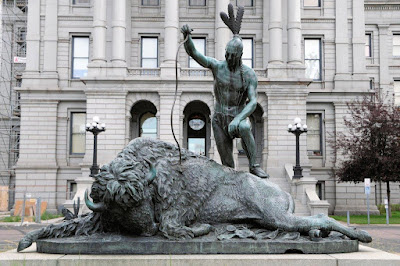State Capitols – Denver, Colorado - Inside
Elijah Myers, the leading architect of government buildings in the late 19th century, designed the Colorado capitol. He is the only person who created three state houses, the others being in Michigan and Texas. There was a second post for each of the capitols (MI and TX).
The legislative chambers’ furnishings are mostly original. The lighting has been improved to accommodate television cameras. The capitol is large enough to house offices for each of the 35 senators and 65 representatives.
The House consists of 65 members elected to two-year terms. After my visit, from 2014-16, the House and Senate chambers were renovated to restore them to their former historic appearance. Ten years ago, this capitol became the first state house in the country to be cooled by geothermal power.
Many state houses of that era had grand staircases. Grand interior spaces all decorated and embellished need a grand way to access the next floor. To reinforce the word more, it’s a grand place for meet-ups and group photographs.
Unique to this building is the rose onyx marble that lines the grand staircase and other parts of the building. It took six years to fashion and install and it turns out that the now-depleted source of this type of marble near Pueblo had just enough to complete the job. The stone has not been found anywhere else on the planet.
The Colorado capital city is also the state’s most populous. Sixteen other states can say the same. Maybe it’s the size of the city that triggers the following impression. Big cities have issues. More people often mean more people with difficulties. It’s a proportional thing. Maybe Denver has gotten a handle on this after twelve years but in 2011, the capitol grounds were not in good shape. The landscaping was unkempt and many homeless were about. While I was there, an ambulance came to treat someone who was unresponsive.
The other big city trait was the level of security at the entrance. As I’ve noted before, while some state houses are open, inviting and easy to enter, others take security to a much higher level. While the capitol police here were friendly, I did have to pass everything I was carrying through their machine before I was allowed to enter. Such is life in the Big City.
Still, a fascinating, gleaming, shiny capitol that I was glad to visit.
















.jpg)
.jpg)
.jpg)
.jpg)

